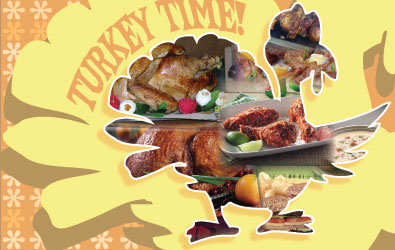What you're really celebrating at Thanksgiving
Illustration by Josh Harding

By Jennifer Palmberg
The Collegian
Most people are familiar with the story of the first Thanksgiving. Pilgrims sailing for what was then northern Virginia were blown off course by a storm and landed at Plymouth Rock in 1621 and decided to stay.
The first winter was very hard for them since they didn’t have enough time to build proper housing or save up enough food. About half of them died. The Pilgrims were later approached by Wampanoag Indians, who had learned the English language from fishermen.
The Wampanoag taught them how to farm, hunt and fish effectively, according to historychannel.com.
Many believe the first Thanksgiving was held in 1621 as a sign of thanks from the Pilgrims to the Wampanoag Indians, but that’s not true. Thanksgiving was actually aPuritan religious tradition in which they would spend hours in church giving thanks to God for specific events such as the victory of a battle.
The first feast, held between the Wampanoag Indians and the Pilgrims, was not held in honor of Thanksgiving nor was it held traditionally year after year.
The original gathering lasted for three days ending on a Saturday night and included feasting, music, dancing and games. It wasn’t the simple singular meal celebrated in today’s tradition.
The three-day feast was actually held in tradition of an English harvest festival. The Pilgrims prayed and fasted on a traditional day of Thanksgiving, at a period of drought in 1623, in hopes that God would spare their harvest. During their prayer it began to rain. From then on celebrating a day of Thanksgiving after the start of the harvest season became traditional.
Over the years, the three-day harvest festival and the day of Thanksgiving became a single celebration rather than two separate celebrations. In honor of the three-day celebration Thanksgiving is always held on a Thursday to entail a three-day weekend. (Sunday was considered to be the first day of the new week.) This is the holiday we celebrate today, according to historychannel.com.
The foods Americans eat in honor of Thanksgiving didn’t necessarily originate from the original feast among the Pilgrims and Wampanoag Indians.
In 1621 the most abundant foods available were cod, eel, lobster, wild turkey, goose, duck, venison, seal, Indian corn, wheat flour, pumpkin, peas, beans, plums, and grapes. These were eaten at the original feast.
The most common foods were meats, mostly in the form of fowl, which is why many Americans celebrate Thanksgiving by eating turkey. Pumpkin pie didn’t exist yet and cows were not available for dairy foods such as milk, cheese, butter, or mashed potatoes.
A traditional Thanksgiving dinner today might include ham, potatoes, corn on the cob, stuffing and cranberry sauce, which was not part of the original feast. So when you sit down on Thursday to stuff yourself with all of the abundant foods at your table, make sure you understand what it is you’re really celebrating and don’t forget to share what you’re truly thankful for.
Comment on this story in the Features forum >>
|
